When do hunts usually start and end?
Hunts typically begin 30 minutes before official sunrise, aligning with legal shooting hours. Most hunts conclude by 9:00 a.m. or earlier if the daily bag limit is reached. This early timeframe maximizes bird movement, which tends to slow as the morning progresses. By finishing before mid-morning, hunters also help preserve rest areas and minimize pressure on the waterfowl population.
Can hunters bring retriever dogs?
Yes, retriever dogs are allowed for hunting parties of four or more. However, arrangements must be made in advance to ensure compatibility with the hunting setup and other participants. Trained retrievers can greatly enhance the efficiency of bird recovery, especially in water-heavy environments or tall cover. Handlers should ensure dogs are steady, quiet, and under control at all times to avoid disrupting the hunt.
Are afternoon hunts available?
Afternoon hunts are generally not offered. Waterfowl activity in North Texas peaks during early morning hours, making afternoon hunts less productive. Additionally, late-day hunting can disturb resting birds, reducing future hunting success. The focus remains on sustainable and ethical practices that protect long-term habitat use and bird behavior.
What affects hunt success?
Several key factors influence the success of a hunt:
- Weather Conditions: Overcast skies, cold fronts, or light wind often improve bird movement.
- Bird Migration: Success depends on timing within the season and the presence of migrating flocks.
- Shooting Skill: Accurate and ethical shooting increases the likelihood of reaching limits.
- Concealment and Setup: Effective blind placement and decoy spread arrangement are critical.
- Scouting Quality: Hunts that follow thorough scouting reports typically yield better results.
Even when bag limits aren’t met, many hunters consider a day successful if birds work the decoys, shots are well-taken, and conditions provide learning and enjoyment.
What should hunters expect after confirming plans?
Once plans for a hunt are made, each hunter should verify that all licensing and regulatory requirements are met. This includes a valid Texas hunting license, a Federal Duck Stamp, and any necessary state waterfowl endorsements. Final details, such as meeting time, weather updates, and hunting area assignment, are usually determined the evening before the outing. These are based on scouting information and current bird movement. Most groups arrive approximately 90 minutes before legal shooting time to allow for setup and preparation.
What happens if plans change?
To confirm a planned hunt, an advance commitment is often required. This commitment is typically non-refundable, as it reflects the preparation and coordination involved in arranging each outing. If the number of participants changes afterward, the original terms generally remain based on the group size that was initially confirmed. While adjustments may be possible in specific situations, they usually depend on availability and prior planning.
Are tips for guides expected?
While not mandatory, tips are a common way to show appreciation for a guide’s expertise and effort. Hunters often consider factors such as punctuality, scouting accuracy, field preparation, and overall professionalism when determining gratuity. Tips may vary depending on the quality of the experience, regardless of whether the bag limit was reached.
